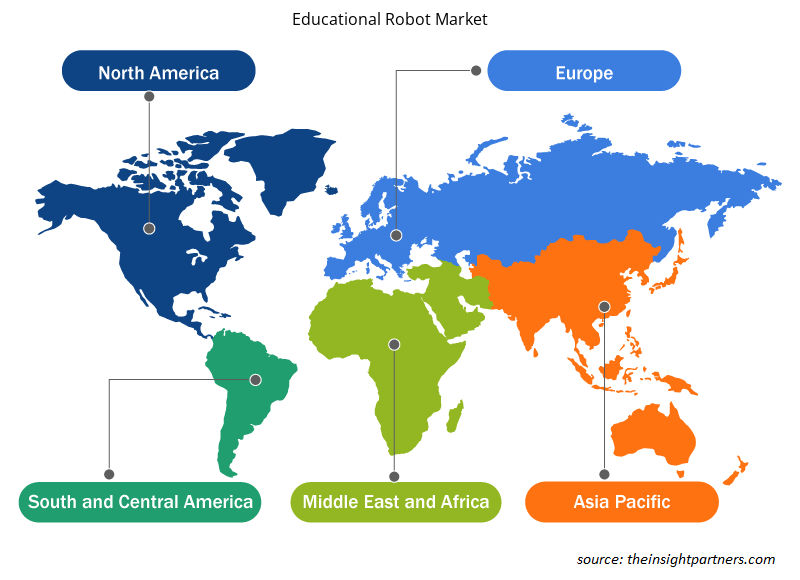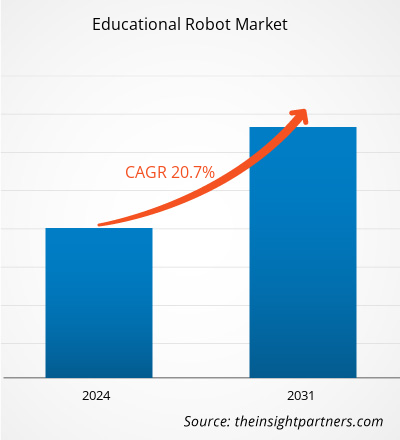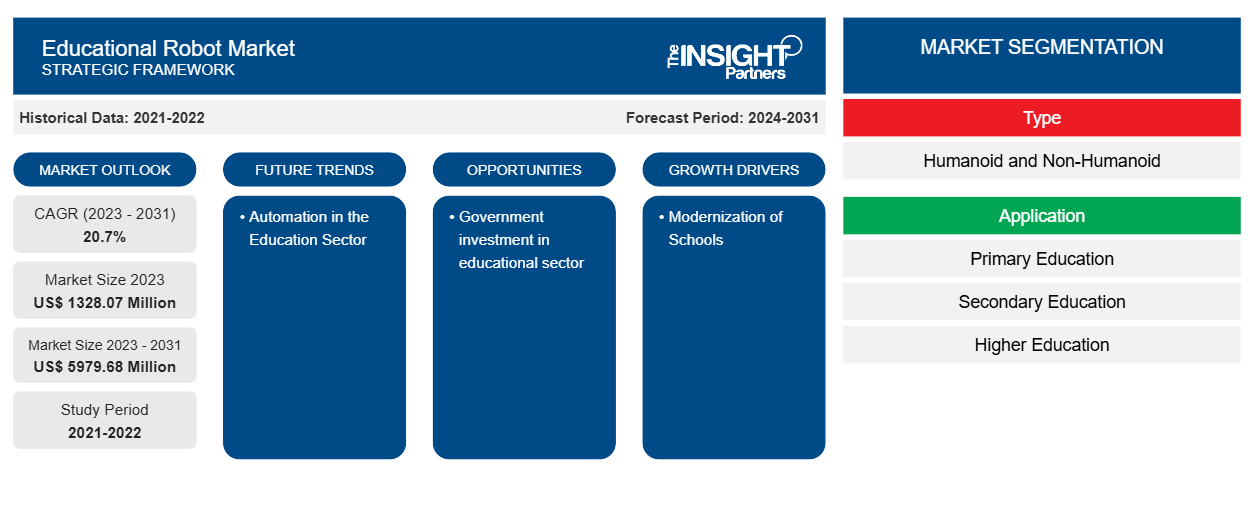교육용 로봇 시장은 2023년 13억 2,807만 달러에서 2031년까지 5,979.68만 달러로 성장할 것으로 예상됩니다. 이 시장은 2023~2031년 동안 20.7%의 CAGR을 기록할 것으로 예상됩니다 . 교육 부문에서 로봇 및 자동화에 대한 정부 투자는 시장의 주요 추세로 남을 가능성이 높습니다.
교육용 로봇 시장 분석
과학, 기술, 공학, 수학(STEM)을 강화하는 데 대한 관심이 커지면서 시장 성장이 촉진되고 있습니다. 정부 당국의 교육 시스템에 대한 투자는 시장 성장을 더욱 촉진합니다. 학교와 단과대학은 시장 성장을 촉진하는 로봇공학의 다양한 측면을 포함하고 있습니다.
교육용 로봇 시장 개요
교육용 로봇은 모든 연령대의 학생들이 로봇공학과 프로그래밍에 대한 지식을 심화할 수 있도록 하는 프로그래밍 가능한 로봇입니다. 또한 다른 인지 기술을 배우는 데 도움이 됩니다. 학생들에게 다양한 작업을 수행할 수 있는 로봇을 만들고 프로그래밍하는 데 필요한 모든 것을 제공합니다.
귀하의 요구 사항에 맞게 이 보고서를 사용자 정의하세요
이 보고서의 일부 또는 국가 수준 분석, Excel 데이터 팩을 포함하여 모든 보고서에 대한 사용자 정의를 무료로 받을 수 있으며 신생 기업 및 대학을 위한 훌륭한 혜택과 할인 혜택을 이용할 수 있습니다.
-
이 보고서의 주요 시장 동향을 알아보세요.이 무료 샘플에는 시장 동향부터 추정 및 예측까지 다양한 데이터 분석이 포함됩니다.
교육용 로봇 시장 동인 및 기회
학교의 현대화
정부는 학교와 대학을 현대화하고 학생들의 학습을 더욱 강화하기 위해 교육 부문에 막대한 투자를 하고 있습니다. 이러한 투자는 시장 참여자들이 학교에 교육용 로봇을 제공하도록 장려하고 있으며, 이는 시장 성장을 촉진하고 있습니다. 예를 들어, 2022년 4월 덴마크의 Shape Robotics는 루마니아의 학교에 교육용 로봇을 배포하기 위해 현지 동업사인 KUBO Robots와 계약을 체결했다고 밝혔습니다.
교육 분야의 자동화
ABB가 2,301명의 교육 전문가를 대상으로 실시한 2023년 글로벌 설문 조사에서 80%가 로봇과 자동화가 향후 10년 동안 고용의 미래를 형성할 것이라고 믿는 것으로 나타났습니다. 교육 시스템과 교육 프로그램에서 로봇 활용. 산업용 로봇 시장 참여자들은 교육 부문에서 로봇을 출시하는 데 주력하고 있으며, 이는 미래에 교육용 로봇 시장을 활성화할 수 있습니다.
교육용 로봇 시장 보고서 세분화 분석
교육용 로봇 시장 분석에 기여한 핵심 세그먼트는 유형과 응용 분야입니다.
- 교육용 로봇 시장은 유형에 따라 휴머노이드와 비휴머노이드로 세분화됩니다. 비휴머노이드 세그먼트는 2023년에 시장에서 가장 큰 점유율을 차지했습니다.
- 응용 프로그램별로 시장은 초등 교육, 중등 교육, 고등 교육 및 기타로 세분화됩니다. 다른 세그먼트는 2023년에 시장에서 상당한 점유율을 차지했습니다.
지역별 교육용 로봇 시장 점유율 분석
교육용 로봇 시장 보고서의 지리적 범위는 주로 북미, 아시아 태평양, 유럽, 중동 및 아프리카, 남미 및 중부 아메리카의 5개 지역으로 나뉩니다.
아시아 태평양 지역은 예측 기간 동안 가장 높은 CAGR 로 성장할 것으로 예상됩니다 . 이 지역은 교육 부문의 기술 발전에 초점을 맞추고 있습니다. 교육 부문에 대한 투자 증가는 시장 성장을 보완합니다 . 학교에 로봇을 도입하면 이 지역의 시장 성장이 더욱 촉진됩니다. 예를 들어, 2024년 3월, 케랄라의 한 학교는 교육을 향한 혁신적인 발걸음을 내딛기 위해 국가 최초의 AI 교사인 Iris를 도입했습니다. Iris는 Makerlabs Edutech 와 협력하여 만들어졌으며 주와 아마도 국가 최초의 휴머노이드 로봇 교사입니다. Iris는 다양한 과목에 걸쳐 복잡한 질문에 답하고, 개별화된 음성 지원을 제공하며, 대화형 교육 기회를 홍보할 수 있습니다. 또한 Iris에는 이동성을 높이기 위한 바퀴가 장착되어 있습니다.
교육용 로봇 시장 지역 통찰력
Insight Partners의 분석가들은 예측 기간 동안 교육용 로봇 시장에 영향을 미치는 지역적 추세와 요인을 철저히 설명했습니다. 이 섹션에서는 북미, 유럽, 아시아 태평양, 중동 및 아프리카, 남미 및 중미의 교육용 로봇 시장 세그먼트와 지리에 대해서도 설명합니다.

- 교육용 로봇 시장에 대한 지역별 데이터 얻기
교육용 로봇 시장 보고서 범위
| 보고서 속성 | 세부 |
|---|---|
| 2023년 시장 규모 | 13억 2,807만 달러 |
| 2031년까지 시장 규모 | 59억 7,968만 달러 |
| 글로벌 CAGR (2023-2031) | 20.7% |
| 역사적 데이터 | 2021-2022 |
| 예측 기간 | 2024-2031 |
| 다루는 세그먼트 |
유형별로
|
| 포함된 지역 및 국가 |
북아메리카
|
| 시장 선도 기업 및 주요 회사 프로필 |
|
교육용 로봇 시장 참여자 밀도: 비즈니스 역학에 미치는 영향 이해
교육용 로봇 시장은 소비자 선호도의 변화, 기술 발전, 제품의 이점에 대한 인식 증가와 같은 요인으로 인해 최종 사용자 수요가 증가함에 따라 빠르게 성장하고 있습니다. 수요가 증가함에 따라 기업은 제품을 확장하고, 소비자의 요구를 충족하기 위해 혁신하고, 새로운 트렌드를 활용하여 시장 성장을 더욱 촉진하고 있습니다.
시장 참여자 밀도는 특정 시장이나 산업 내에서 운영되는 회사나 기업의 분포를 말합니다. 주어진 시장 공간에 얼마나 많은 경쟁자(시장 참여자)가 존재하는지 그 규모나 전체 시장 가치에 비해 나타냅니다.
교육용 로봇 시장에서 활동하는 주요 회사는 다음과 같습니다.
- 아이소이 로보틱스
- 핸슨 로보틱스 리미티드
- 모듈식 로봇공학
- 팔 로보틱스
- FANUC 아메리카 주식회사
- 산봇 이노베이션 테크놀로지 유한회사
면책 조항 : 위에 나열된 회사는 어떤 특별한 순서에 따라 순위가 매겨지지 않았습니다.

- 교육용 로봇 시장의 주요 기업 개요를 알아보세요
교육용 로봇 시장 뉴스 및 최근 동향
교육용 로봇 시장은 1차 및 2차 연구 이후의 질적, 양적 데이터를 수집하여 평가합니다. 여기에는 중요한 기업 출판물, 협회 데이터, 데이터베이스가 포함됩니다. 교육용 로봇 시장의 몇 가지 개발 사항은 다음과 같습니다.
- ABB Robotics는 IRB 1090 출시로 교육 제공을 확대했습니다. 세계적으로 인정받는 교육 기관 STEM.org에서 인증한 1090 산업 교육 로봇은 학생들의 기술을 향상시키고 취업을 확보하는 데 있어 경쟁 우위를 제공하도록 설계되었습니다. 새로운 교육 로봇은 추가 산업 로봇, 교육 패키지, 차세대 컨트롤러, 시장을 선도하는 프로그래밍 및 시뮬레이션 소프트웨어를 포함하는 ABB의 광범위한 교육 제공의 핵심 부분을 형성합니다. (출처: ABB Robotics, 보도 자료, 2023년 9월)
- 혁신과 독창성을 핵심으로 하는 디지털 학습 솔루션 제공업체인 MatataStudio는 컴퓨터 과학, 인공지능, 교육을 재미있게 결합하는 것을 목표로 하는 "VinciBot"이라는 새로운 교육용 로봇 키트를 출시했습니다. (AI) 및 머신 러닝(ML)과 같은 하이테크 개념이 초등학교 교실에 도입되었습니다. 이러한 로봇 키트는 교육적일 뿐만 아니라 프로그래밍, 계산적 사고, 창의성, 탐구를 통합합니다. MatataStudio의 디자인 컨셉은 아이들이 직접 로봇을 만들고 작동하면서 혁신적인 사고와 문제 해결 능력을 기르면서 프로그래밍과 컴퓨터 과학에 대한 기본 지식을 습득하도록 장려하는 것입니다. (출처: MatataStudio, 보도자료, 2024년 2월)
교육용 로봇 시장 보고서 범위 및 제공물
"교육용 로봇 시장 규모 및 예측(2021-2031)" 보고서는 아래 영역을 포괄하는 시장에 대한 자세한 분석을 제공합니다.
- 범위에 포함된 모든 주요 시장 세그먼트에 대한 글로벌, 지역 및 국가 수준의 교육용 로봇 시장 규모 및 예측
- 교육용 로봇 시장 동향과 드라이버, 제지장치, 주요 기회와 같은 시장 역학
- 자세한 PEST/포터의 5가지 힘과 SWOT 분석
- 주요 시장 동향, 글로벌 및 지역 프레임워크, 주요 업체, 규정 및 최근 시장 개발 사항을 포괄하는 교육용 로봇 시장 분석
- 시장 집중도, 히트맵 분석, 유명 업체, 교육용 로봇 시장의 최근 동향을 포괄하는 산업 환경 및 경쟁 분석
- 자세한 회사 프로필
- 과거 분석(2년), 기준 연도, CAGR을 포함한 예측(7년)
- PEST 및 SWOT 분석
- 시장 규모 가치/거래량 - 글로벌, 지역, 국가
- 산업 및 경쟁 환경
- Excel 데이터세트
최근 보고서
관련 보고서
사용 후기
구매 이유
- 정보에 기반한 의사 결정
- 시장 역학 이해
- 경쟁 분석
- 고객 인사이트
- 시장 예측
- 위험 완화
- 전략 기획
- 투자 타당성 분석
- 신흥 시장 파악
- 마케팅 전략 강화
- 운영 효율성 향상
- 규제 동향에 발맞춰 대응























 무료 샘플 받기 - 교육용 로봇 시장
무료 샘플 받기 - 교육용 로봇 시장